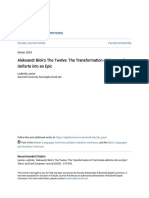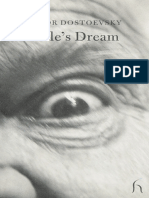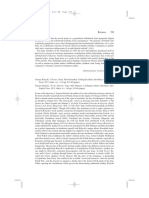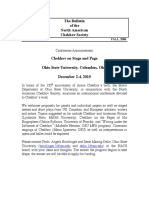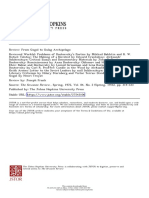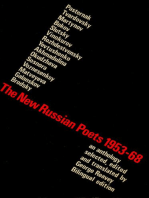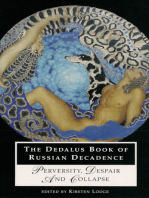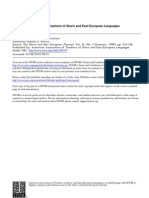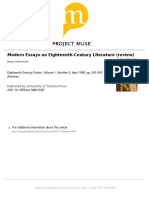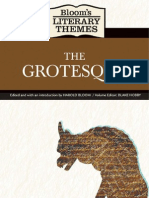The Gothic-Fantastic in Nineteenth-Century Russian Literature - Neil Cornwell
The Gothic-Fantastic in Nineteenth-Century Russian Literature - Neil Cornwell
Uploaded by
johnsapCopyright:
Available Formats
The Gothic-Fantastic in Nineteenth-Century Russian Literature - Neil Cornwell
The Gothic-Fantastic in Nineteenth-Century Russian Literature - Neil Cornwell
Uploaded by
johnsapCopyright
Available Formats
Share this document
Did you find this document useful?
Is this content inappropriate?
Copyright:
Available Formats
The Gothic-Fantastic in Nineteenth-Century Russian Literature - Neil Cornwell
The Gothic-Fantastic in Nineteenth-Century Russian Literature - Neil Cornwell
Uploaded by
johnsapCopyright:
Available Formats
BookReviews 935
TheGothic-Fantastic
in Nineteenth-Century Ed. Neil Cornwell.Studiesin
RussianLiterature.
SlavicLiteratureand Poetics,vol. 33. Amsterdam:Rodopi, 1999. 293 pp. Notes. Bib-
liography.Index. $55.50, paper.
This volume is based on the proceedingsof a symposiumon Russian gothicheld at the
University of Bristolin 1997. Even thoughthe essaysdifferin theirscope, methodology,
and theoreticalconcerns,each has somethingto offer.Regardlessof theindividualessays'
strengths, however,thecollectionas a whole does not cohere,since neithertheeditor'sin-
troduction,whichoutlinesthe historyof the genre and summarizestheworkof itsEuro-
pean and Russianpractitioners, nor thefineand thoughtful essaybyRichardPeace, which
tracesthe metamorphosisof pagan gods into the gothicPandemoniumof devils,provide
thevolumewiththe unityit needs. The situationcould have been partiallyremediedbya
comprehensiveintroductory essayaddressingthe cultural,social,and psychologicalissues
thatthe gothicgenreprovedsuch a perfectvehicle to explore and exploit.Besides such a
theoreticalessay,thevolume should have also included a more thoroughtreatmentofin-
dividualRussianromantics(thereis nothingin thevolume on AntoniiPogorel'skii,Orest
Somov,MikhailLermontov,or earlyNikolai Gogol') and the studyof Russiansymbolists.
Both Cornwelland Peace referto the flourishingof Russiangothicin theworksof Fedor
Sologub, DmitriiMerezhkovskii, and Andrei Belyi,yet the volume containsnothingon
theseauthors.Grantedthatthe editor'sfocuswas on the nineteenthcentury, the omission
of symbolisttexts-even thoughsome were produced in the twentiethcentury-never-
thelessdistortsthe pictureof the Russiangothic.
The essaysincluded in the volume can be dividedinto twogroups.The first,explor-
ing pre-Pushkintexts,seems to be guided bythe philologicalresearchon Russianroman-
ticismcarried out by Vadim Vatsuro (an excellent Russian scholar,recentlydeceased),
while the second group is inspiredbyTsvetanTodorov'sworkon the fantastic.Derek Of-
ford'sessayon Nikolai Karamzin,AlessandraTosi's studyof Nikolai Gnedich, and Roger
Cockrell'sanalysisof VladimirOdoevskii's "Cosmorama,"all informative, nuanced, bal-
anced, and intelligent, provideexamplesofVatsuro'shistorico-philological approach. Of-
fordoffersa sophisticatedanalysisof Karamzin'sanxietiesas theyinformhis gothicnarra-
tive,"The Island of Borgholm"(1792). Accordingto Offord,Karamzin'ssentimentalism,
conservatism, and pessimism,reawakenedas theywere bythe eventsof the FrenchRevo-
lution,found a perfectvehicle in the complex moral visionof his tale. Tosi sketchesthe
historyof the earlyRussian involvementwithgothic,while arguingconvincingly for the
primacyof Gnedich's Don Carrado de Gerrera(1803), both withinthe historyof Russian
gothicand ofRussia'sdemonic characters,whose psychological,moral,and philosophical
anticsfoundtheirearlyexpressionin the arch-villain, Don Carrado.While unravelingthe
literarybackgroundof Cosmorama,Cockrellapproaches Odoevskii'stextas "a synthesis of
theromanticand rationalimpulseswithinOdoevsky"(143) and providesa convincingex-
positionof the text'smoral,ontological,and epistemologicalconcerns.
Michael Pursglove'sessayon VasiliiZhukovskiiis ratherdisappointing,since he does
not avoid the pitfallthatawaitsany philologicallyorientedscholar:an attemptto deter-
mine whethersome text,whose literaryvalue is farfromclear, fitsinto some not easily
definedgenre. Pursglovesummarizesand profuselyquotes fromseveralof Zhukovskii's
ballads and narrativepoems, onlyto maintainthatthe majorityof themare more senti-
mentalthangothic,while others(the 1831 ballad "Donika,"forexample) can indeed be
characterizedas Russian gothicin verse.As scholarsare stillunclear about the shape of
preromanticism, romanticism, and the genresthattheseperiodsgenerated,the compari-
son of various attributesand definitionswould seem to be futile.It is also unclear why
PursgloveignoresZhukovskii's versetranslationof Friedrichde la MotteFouque's Undine,
a textthatcaptured the imagination,not onlyof Zhukovskii,but of such diversefigures
as Gogol', Lermontov,PetrChaikovskii,AleksandrBlok, and Marina Tsvetaevain Russia,
Thomas Carlyleand WalterScott in England, Richard Wagnerin Germany,and Edgar
Allan Poe in the UnitedStates.
The issue of Undine should have also resurfacedin CynthiaRamsey'sdiscussionof
VladimirOdoevskii'stale,"The Salamander."Ramseyignoresthisimportantsubtext,even
This content downloaded from 195.78.108.81 on Fri, 13 Jun 2014 23:26:58 PM
All use subject to JSTOR Terms and Conditions
936 Slavic Review
thoughshe is aware thatOdoevskiiwas workingon his ownversionof "Undine."Further-
more,Ramseymistakenlyclaims thatOdoevskiiinitiallyconceived "The Salamander" as
consistingof three parts,the last one being "Undine,"when in factOdoevskii planned
"Undine"as a separate tale, the thirdin his trilogyabout elementalspirits("The Sylph,"
"The Salamander,"and "Undine"). "The Salamander,"withitswaveringmale protagonist
and devotedand forgiving(to a certainpoint) female,is much closerto La MottFouques
Undinethan to the twosubtextsthatRamseyidentifiesand spends half of her essayre-
telling:TheKalevala and MaryShelley'sFrankenstein. RamseymaintainsthatOdoevskii's
textis preoccupiedwithissuesoforigins,engendering,culturaltransmission, and thecon-
flictbetween fathersand sons. This may be so, yet neitherher unconvincingsubtexts
nor the confusedargumentationhelp the reader to see how theseissuesreallyoperate in
the text.
The group of Todorov-inspired,theoreticallyconcerned studiesof gothic includes
Claire Whitehead'sessay on "The Queen of Spades," which tracesAleksandrPushkin's
technique of unsettlinghis readers and plantinghesitationin theirminds. This tech-
nique includes,accordingto Whitehead,an overabundanceof incompleteinformation,
an unidentifiednarrator,extensiveuse of indefinitepronouns,and frequentswitchesin
point of view.Whitehead thus concentrateson how Pushkin'snovella becomes the very
paradigm of the fantastic,as defined by Todorov. This useful studyis couched, how-
ever, in prohibitively obscure terminology, borrowedfromGerard Genette and other
theoreticians,and thus takes a rathercircuitousroute to make several fairlystraight-
forwardobservations.CarolynJursaAyersis also drivenbytheory,even thoughher essay
on Elena Gan is straightforward and lucid. Ayerstriesto square the concept of "female
gothic"withGan's literaryproduction,her tale "Society'sJudgement"(Sud sveta)in par-
ticular.While not directlyconfrontingthe gothicdimensionof the tale itself,Ayersdis-
cussion of the interplaybetweenfemaleidentity, power,and sexualityhighlightsvarious
literarystrategiesand predicamentsof both Gan and otherfemaleRussianwritersof the
period.
The main purpose of Ignat Avsey'sfree-wheeling, deliberatelyunanalytical,yetfre-
quentlywitty essay,"The Gothicin Gogol and Dostoevsky" is to tiethequintessentialgothic
novel,Horace Walpole's TheCastleofOtranto, not onlyto itsBritishheirs,such as Walter
Scott,CharlesMaturin,or MaryShelley,but also to Gogol' and Fedor Dostoevskiiand their
characters,such as Chichikov,Pliushkin,Fedor Karamazov,and Smerdiakov.It is hard
to disagreewithhim here, althoughone could add the names of Svidrigailov, Stavrogin,
PrinceValkovskii, and Kleopatra,as Dostoevskiiimaginedher, to the listof Dostoevskii's
quasi-gothicvillains.
In her insightful"SupernaturalDoubles: Vii and TheNose,"PriscillaMeyerfocuses
on parallels between two seeminglyquite differentstories by Gogol', exploring how
the supernaturalof the firsttale is reduced, condensed, and "recostumed"(209) in the
St. Petersburgsettingof the lattertale. Accordingto Meyer,"profounduncanniness,the
featurethatis so hard to locate in thePetersburgstories"(209), transports "The Nose" be-
yond a comic parodyof the supernaturaltale into the unrealizedtranscendentworld,the
presenceofwhichis intimatedthroughthe tracesof "Vii"in "The Nose."
Leon Burnett'sessay,vaguelytitled,"The Echoing Heart: Fantasiasof the Female in
Dostoevskyand Turgenev,"concentratesprimarilyon Ivan Turgenev'sshortstory"Faust"
(1856). Burnettobservesthatthe Unknown,whichcontrolsthe eventsof the story, getsits
powerfromeitherthe projection(of the participants)or fromthe actual coercivepower
of possession (251). This is an intriguingthesisthatthe authorunfortunately failsto de-
velop,optinginsteadfora fancifulpursuitof otherissues,such as thevarioustranslations
of a particulartermin TheBrothers Karamazov.A similarfailureto develop a relevantthe-
sis, while pursuingvarious secondaryconcerns,mars Ann Komaromi'sessay on Anton
Chekhov's"BlackMonk."Komaromisuggeststhatgothicawe is experiencedhere bythe
tale'sreadersratherthanitsprotagonistsand is caused not so muchbyKovrin'ssupernat-
uralvisionsas bythe overwhelming destructioncaused bythe banal, everydaydramasthat
theprotagonistsinflictupon each other.These twolastessaysalso seem to share a certain
refusalto engage the criticalliteraturegeneratedbyboth "Faust"and "BlackMonk."
All in all, the collectionprovidesan interestingangle fromwhichto examinevarious
This content downloaded from 195.78.108.81 on Fri, 13 Jun 2014 23:26:58 PM
All use subject to JSTOR Terms and Conditions
BookReviews 937
Russiantextsor authors,even thoughit clearlyfallsshortof both of itsmodels,as it lacks
Vatsuro'sthoroughnessand range,and Todorov'stheoreticalsophistication.
VLADIMIR GOLSTEIN
Yale University
Dostoevsky's
The Devils: A CriticalCompanion.Ed. W.J. Leatherbarrow.Evanston:North-
westernUniversity
Press,1999. ix, 165 pp. Notes. Bibliography.$17.95, paper.
Das Prophetische
in DostojewskijsDamonen. Eds. Olga GroB3mannand Roland Opitz.
Weimar:Verlagund Databank ffirGeisteswissenschaften,
1998. 200 pp. Notes.Photo-
graphs.Figures.DM 29.00, paper.
The twobooks under revieware verydifferent. The Companion containsfourcriticalessays:
an introductionbythe editor,followedbyD. C. Offord'sarticleon the novel'scontempo-
rarycontext,M. V.Jones'sanalysisof itsnarrativetechniques,and R. M. Davison'spiece on
the role of Stepan Trofimovich Verkhovenskii. In addition,the editorhas translatedrele-
vantextractsfromFedor Dostoevskii'scorrespondenceand providedthebook withan an-
notatedbibliography.
The German publicationis a miscellanyof eighteen papers given at a symposium
in Dresden in November1996. In additionto papersdirectlyconcernedwiththenovel,its
background,and itsreceptionin Russia afterthe fallof the SovietUnion, thisworkdeals
witha numberof different topics,such as Dostoevskiiand modern informationtechnol-
ogy (Vladimir Zakharov), the Dostoevskiimuseum at St. Petersburg(Natalia Ashem-
baieva), Dostoevskiiin Dresden (Erhard Hexelschneider),and the birthof Dostoevskii's
daughterin Dresden, withfacsimiles-published by Olga Grol3man-documenting his
daughter'sbirthand subsequentbaptismin the city'sRussian Orthodox churchon 12/
24 January1870, not in December 1869, the date givenbyDostoevskii'swifein her mem-
oirsand lateraccepted byDostoevskiischolars.
It is oftensaid about TheDevilsthatitiswell-nighinaccessibleto readerswithouta cer-
tainknowledgeof the "politicalrealia" thatservedas Dostoevskii'srawmaterial,especially
the destructiveactivitiesof Russian anarchistsin the 1860s. Scholars have traditionally
linkedthe main plot of TheDevils,culminatingin the murderof Shatov,withthe theories
of M. A. Bakunin and the conspiratorialpursuitsof his young disciple, S. G. Nechaev,
whichreached theirclimaxwiththe murderof the studentI. I. Ivanov on 21 November
1869. In the English companion, the novel's historicalcontext is discussed both by
Leatherbarrowin his introductory essayand, more extensively,byD. C. Offord,while in
the German collection,the theme is taken up by Gudrun Braunspergerin an essayon
Nechaev and powerin the serviceof the revolution.
Several of the Russian participantsat the Dresden symposiumhave chosen to read
TheDevilsas a propheticforeshadowing ofBolshevikterrorism and thelawlessnessofpost-
Soviet Russian society.This is by no means a new approach to Dostoevskii.But when
applied to today'ssocial problems,as in the contributionof the Moscow criminologist
NikolaiPenshin,itfailsto convincethe reader.Penshin'sattemptto explain the spread of
organizedcrime,the activitiesof Chechen rebels,and the shenanigansof Russianpoliti-
cians as a fulfillment of eventspredictedin Crimeand Punishment and TheDevilsis a rather
sad gloss on the stateof Russian criminologyand on post-SovietDostoevskiistudiesin
Russia. Moreover,Penshin is not alone in claimingthatthe disastersthathave befallen
present-day Russiaare theresultsofmodernatheismand theabandonmentof theOrtho-
dox faith.On the contrary, similarargumentsare typicalof thewayTheDevilshas been re-
ceived in Russia duringthe last decade (as iftherewere no crimeunder the Romanovs).
As shownin Karla Hielscher'swell-researchedpaper, TheDevilshas become a weapon in
the hands of people interestedin foregroundingthe reactionary, nationalistic,and anti-
Semiticstrainsof Dostoevskii'soeuvre.
If thisis the general trend,Igor Vinogradov'scomparativeanalysisof Shigalevin The
This content downloaded from 195.78.108.81 on Fri, 13 Jun 2014 23:26:58 PM
All use subject to JSTOR Terms and Conditions
You might also like
- Sunlight at Midnight - St. Petersburg and The Rise of Modern RussiaDocument467 pagesSunlight at Midnight - St. Petersburg and The Rise of Modern Russiayakumi.somokuriNo ratings yet
- Orwin D T The Cambridge Companion To TolstoyDocument289 pagesOrwin D T The Cambridge Companion To TolstoyИлья Бендерский75% (4)
- Fyodor Dostoevskys Netochka NezvanovaDocument78 pagesFyodor Dostoevskys Netochka NezvanovacarlospinheirotorresNo ratings yet
- Tolstoy or Dostoevsky: An Essay in the Old CriticismFrom EverandTolstoy or Dostoevsky: An Essay in the Old CriticismRating: 4 out of 5 stars4/5 (17)
- Dostoevsky in Moderation Thomas MannDocument10 pagesDostoevsky in Moderation Thomas Manncarlos100% (1)
- Adrian Wanner - Russian Minimalist Prose - Generic Antecedents To Daniil Kharms'sDocument23 pagesAdrian Wanner - Russian Minimalist Prose - Generic Antecedents To Daniil Kharms'sthjørnetNo ratings yet
- Kafka and Dostoevsky AsDocument5 pagesKafka and Dostoevsky AsvesteroseNo ratings yet
- Odoevsky's four pathways into modern fiction: A comparative studyFrom EverandOdoevsky's four pathways into modern fiction: A comparative studyNo ratings yet
- Preface: O Teoriiprozy (Moskva, Federacija, 1929) P. 204Document4 pagesPreface: O Teoriiprozy (Moskva, Federacija, 1929) P. 204Umut ErdoganNo ratings yet
- Aleksandr Bloks The Twelve - The Transformation of Commedia DellDocument22 pagesAleksandr Bloks The Twelve - The Transformation of Commedia DellJuan Antonio HernandezNo ratings yet
- OceanofPDF - Com Uncles Dream - Fyodor DostoevskyDocument172 pagesOceanofPDF - Com Uncles Dream - Fyodor DostoevskyMilica Kaburu-JovanovicNo ratings yet
- A Bilingual Collection of Russian Short Stories - Friedberg, Maurice, 1929 - 1964 - New York, Random House - Anna's ArchiveDocument392 pagesA Bilingual Collection of Russian Short Stories - Friedberg, Maurice, 1929 - 1964 - New York, Random House - Anna's ArchiveLuis Alfonso De La Cruz CabreraNo ratings yet
- Review of Colonies and Twelve Station by PDFDocument3 pagesReview of Colonies and Twelve Station by PDFkurytybanczykNo ratings yet
- Kropotkin - Ideals and Realities in Russian LiteratureDocument358 pagesKropotkin - Ideals and Realities in Russian LiteratureDale R. Gowin100% (1)
- Chekhov SocietyDocument53 pagesChekhov SocietyRose BeckNo ratings yet
- Translator's Afterword To I Burn ParisDocument7 pagesTranslator's Afterword To I Burn ParisTwisted Spoon PressNo ratings yet
- Surrealism in 20th-Century Russian PoetryDocument14 pagesSurrealism in 20th-Century Russian PoetryJillian TehNo ratings yet
- Heroine Abuse: Dostoevsky's "Netochka Nezvanova" and the Poetics of CodependencyFrom EverandHeroine Abuse: Dostoevsky's "Netochka Nezvanova" and the Poetics of CodependencyNo ratings yet
- Dostoevsky in English and Shakespearean UniversaliDocument16 pagesDostoevsky in English and Shakespearean UniversalifdjsalkalierqzNo ratings yet
- This Content Downloaded From 93.235.232.185 On Mon, 14 Nov 2022 13:03:28 UTCDocument21 pagesThis Content Downloaded From 93.235.232.185 On Mon, 14 Nov 2022 13:03:28 UTCSinan SakicNo ratings yet
- The Terror of Normality in Jerzy Kosinski's "The Painted Bird"Document13 pagesThe Terror of Normality in Jerzy Kosinski's "The Painted Bird"unanamasNo ratings yet
- Board of Regents of The University of Oklahoma World Literature TodayDocument3 pagesBoard of Regents of The University of Oklahoma World Literature TodaymoonwhiteNo ratings yet
- A Homeric Hymn To Stalin Performing Safe Criticism in Ancient GreekDocument19 pagesA Homeric Hymn To Stalin Performing Safe Criticism in Ancient GreekkurkocobNo ratings yet
- various_best-russian-short-storiesDocument168 pagesvarious_best-russian-short-storiesThy NguyenNo ratings yet
- The World of RaskolnikovtDocument7 pagesThe World of RaskolnikovtSamuel VillegasNo ratings yet
- The Man Who Couldn't Die: The Tale of an Authentic Human BeingFrom EverandThe Man Who Couldn't Die: The Tale of an Authentic Human BeingRating: 3.5 out of 5 stars3.5/5 (3)
- By Nadine Natov2Document2 pagesBy Nadine Natov2Ilona KissNo ratings yet
- Discretion - The Unpretentious Text inDocument20 pagesDiscretion - The Unpretentious Text inMaría Piedad Fernandez CortesNo ratings yet
- Slavic Review: Taras Bul'ba, Which Was Considered To Be The Most Typical of All of Gogol's WorksDocument2 pagesSlavic Review: Taras Bul'ba, Which Was Considered To Be The Most Typical of All of Gogol's Workswalid princoNo ratings yet
- The Editors and Board of Trustees of The Russian ReviewDocument18 pagesThe Editors and Board of Trustees of The Russian ReviewSergio M.No ratings yet
- The Dedalus Book of Russian Decadence: Perversity, Despair & CollapseFrom EverandThe Dedalus Book of Russian Decadence: Perversity, Despair & CollapseRating: 4.5 out of 5 stars4.5/5 (6)
- Dead Souls-Nikolai GogolDocument374 pagesDead Souls-Nikolai GogoletheriNo ratings yet
- Dostoievski Demons The Enigmatic GDocument22 pagesDostoievski Demons The Enigmatic Gzcapg17No ratings yet
- Dead Souls 1916 Go GoDocument340 pagesDead Souls 1916 Go Gomeryemselinunal78No ratings yet
- Description - Arkadii DragomoshchenkoDocument136 pagesDescription - Arkadii Dragomoshchenkoedcrtfvyghbunj100% (2)
- 07 Chapter1Document43 pages07 Chapter1Dhruva PrathyushNo ratings yet
- The Relevance of George Sand's Lucrezia Floriani For Dostoevsky'sDocument8 pagesThe Relevance of George Sand's Lucrezia Floriani For Dostoevsky'sAdn GenNo ratings yet
- Schulz and World LiteratureDocument24 pagesSchulz and World LiteratureVikram Teva RajNo ratings yet
- Nabokovs Time Doubling From The Gift To PDFDocument41 pagesNabokovs Time Doubling From The Gift To PDFganvaqqqzz21No ratings yet
- Wiley The Russian Review: This Content Downloaded From 202.96.31.9 On Thu, 16 Jan 2020 01:55:21 UTCDocument4 pagesWiley The Russian Review: This Content Downloaded From 202.96.31.9 On Thu, 16 Jan 2020 01:55:21 UTCmoonwhiteNo ratings yet
- Ashes by Stefan Żeromski Helen Stankiewicz-Zand (The Slavonic and East European Review, Vol. 8, Issue 22) (1929)Document3 pagesAshes by Stefan Żeromski Helen Stankiewicz-Zand (The Slavonic and East European Review, Vol. 8, Issue 22) (1929)Marko MarkoniNo ratings yet
- Romaticism and The GothicDocument10 pagesRomaticism and The GothicLucia InglesNo ratings yet
- 10 Literary Masterpieces On Which Every Russian Was Raised - Russia BeyondDocument14 pages10 Literary Masterpieces On Which Every Russian Was Raised - Russia BeyondusuarioNo ratings yet
- Essential Novelists - Nikolai Gogol: the foundations of Russian realismFrom EverandEssential Novelists - Nikolai Gogol: the foundations of Russian realismNo ratings yet
- 1 3 HammondDocument4 pages1 3 Hammondnahla_staroNo ratings yet
- The Grotesque Harold Bloom's Literary ThemesDocument237 pagesThe Grotesque Harold Bloom's Literary ThemesDavid Suming Sheu100% (4)
- NQ 50.1.88Document1 pageNQ 50.1.88kaskoskasNo ratings yet
- The Editors and Board of Trustees of The Russian Review, Wiley The Russian ReviewDocument5 pagesThe Editors and Board of Trustees of The Russian Review, Wiley The Russian ReviewmoonwhiteNo ratings yet
- Modern Literature and The Death of GodDocument163 pagesModern Literature and The Death of Godlola100% (1)
- Camus DostoevskyDocument15 pagesCamus DostoevskyHarris Lazaris100% (2)
- Muharem Bazdulj - The Second Book (Writings From An Unbound Europe) - Northwestern University Press (2005) PDFDocument154 pagesMuharem Bazdulj - The Second Book (Writings From An Unbound Europe) - Northwestern University Press (2005) PDFjeff tehNo ratings yet
- Point of View and The Imagination in Dostoevskij's "White Nights"Document14 pagesPoint of View and The Imagination in Dostoevskij's "White Nights"abilashrevocaresolutionsNo ratings yet
- White NightsDocument309 pagesWhite Nightsmjutt2974No ratings yet
- CrimeAndPunishment SGDocument7 pagesCrimeAndPunishment SGalphinjosephcuteNo ratings yet
- The New Age Vol 1 OrageDocument84 pagesThe New Age Vol 1 Orageonetimeit100% (1)
- Dostoevsky Rowan Williams 2024 Scribd DownloadDocument84 pagesDostoevsky Rowan Williams 2024 Scribd Downloadgalaragenach96No ratings yet
- White NightsDocument321 pagesWhite NightsThe heart shaped SunglassesNo ratings yet
- Bresson Dostoevski Bakhtin Adaptation As Intertextual DialogueDocument9 pagesBresson Dostoevski Bakhtin Adaptation As Intertextual DialogueThiagoNo ratings yet
- Pamela Davidson - The Poetic Imagination of Vyacheslav Ivanov - A Russian Symbolist's Perception of DanteDocument336 pagesPamela Davidson - The Poetic Imagination of Vyacheslav Ivanov - A Russian Symbolist's Perception of DanteJuliano Queiroz AlibertiNo ratings yet
- Essay On SportsmanshipDocument6 pagesEssay On Sportsmanshipxumuqvwhd100% (2)
- MOSCOW Museums ENG96 PrevDocument49 pagesMOSCOW Museums ENG96 PrevSarahSchnNo ratings yet
- Crime and Punishment Guide To AudibleDocument11 pagesCrime and Punishment Guide To AudibleDouglas MackenzieNo ratings yet
- The Demonic: From Aeschylus To Tillich: Wolfgang ZuckerDocument17 pagesThe Demonic: From Aeschylus To Tillich: Wolfgang ZuckerDaniel CorreaNo ratings yet
- (English) Dostoevsky's Genius Life Philosophy (DownSub - Com)Document10 pages(English) Dostoevsky's Genius Life Philosophy (DownSub - Com)emadmansy1973No ratings yet
- Dostoevsky and The Mystery of RussiaDocument5 pagesDostoevsky and The Mystery of RussiaRon LawsonNo ratings yet
- Letters of DostoevskyDocument306 pagesLetters of DostoevskyBrady Lange100% (7)
- 罪与罚Crime and PunishmentDocument566 pages罪与罚Crime and Punishmentsushui444No ratings yet
- Chronicle GA2-240202501-AA2-EV01Document2 pagesChronicle GA2-240202501-AA2-EV01ERIKA SOFIA SERNA PEREZNo ratings yet
- SAT Improving Sentences PracticeDocument7 pagesSAT Improving Sentences PracticemahadisiratNo ratings yet
- Divine and Mortal LovesDocument31 pagesDivine and Mortal LovesMüsel Emmanuel Tabares PardoNo ratings yet
- Poor People: Fyodor DostoevskyDocument24 pagesPoor People: Fyodor DostoevskyFaisal MemonNo ratings yet
- An Honest Thief (Fyodor Dostoyevsky (Dostoyevsky, Fyodor) ) (Z-Library)Document27 pagesAn Honest Thief (Fyodor Dostoyevsky (Dostoyevsky, Fyodor) ) (Z-Library)untuk sembarang dunia mayaNo ratings yet
- Shahid Hameed - BooksDocument15 pagesShahid Hameed - BooksSana JuttNo ratings yet
- Literary Movements For Student-689-703Document15 pagesLiterary Movements For Student-689-703Bárbara PLNo ratings yet
- Born in Exile and Under Western EyesDocument10 pagesBorn in Exile and Under Western EyesJason KennedyNo ratings yet









